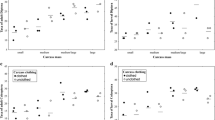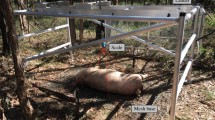Abstract
The decomposition of an inert body seems to depend on the physiological, biological and physical characteristics of the corpse. The effect of these, especially of extra-biological mechanisms, on the rate of decomposition of the corpse does not seem to be sufficiently explored. The present work proposes to examine the influence of the type of feeding on the rate of cadaver decomposition in a human surrogate. It is based on a sample of four corpses of juvenile male pigs of the species Sus scrofa domesticus, three of which are experimental and one is a control aged 12 weeks and having a mass between 19 and 24 kg. The three experimental pigs were fed an energetic, construction and functional diet respectively. The control was fed a general diet. These different carcasses are exposed to the open air on four similar sites. The experiment is repeated twice, according to the protocol that guided the initial experiment conducted on comparable sites (eight cadavers, six experimental and two control). The measurement of the pigs’ diet was done through a questionnaire. The mass of the decomposing carcass was explored by a specific tool, in this case, the weighing device. The results show that the rate of decomposition of the cadaver of pigs fed a general diet is higher than that of the cadavers of their counterparts fed construction, functional or energy diets. The type of diet would therefore influence the rate of decomposition of the cadaver of a human surrogate.


Similar content being viewed by others
Data availability
All data analyzed during this study are included in this published article.
Code availability
Not applicable.
References
Amnesty International (2013) Côte d’Ivoire : la loi des vainqueurs. La situation des droits humains deux ans après la crise post- électorale-2013. https://www.amnesty.org. Accessed 29 April 2021.
Caparros MR (2010) Etude comparative de la colonisation entomologique post- mortem sur carcasses de porc (Sus domesticus L.) mort par overdose de cocaïne et de pentobarbital. Mémoire de Master, Université de Liège. https://www.orbi.uliege.be/bitstream/2268/96864/1/mémoire%20Caparros%20Rudy.pdf. Accessed 14 March 2018
Dekeirsschieter J (2012) Etude des interactions entre l’entomofaune et un cadavre : approches biologique, comportementale et chémo- écologique du coléoptère nécrophage, Thanatophilus sinuatus Fabricius (Col., Silphidae). Thèse de doctorat, Université de Gembloux-Liège. https://www.orbi.uliege.be/bitstream/2268/140720/1/doctoratJ%20Dekeirsschieter.pdf . Accessed 16 February 2018
Bernard C (1966) Leçons sur les phénomènes de la vie communs aux animaux et aux végétaux. Vrin, Paris.
Boggio V (2015) Les nutriments et le métabolisme, Biologie fondamentale. Institut de Formation en Soins Infirmiers de Dijon, Promotion Colliere, Dijon. URL https://www.docplayer.fr-15653100-Dr-boggio-les-nutriments-et-le-metabolisme. Accessed 30 April 2021
Garcia C (2009) L’alimentation : un support d’amélioration de la qualité de vie du résident en EHPAD. Mémoire de Master, Rennes, Ecole des hautes études en Santé Publique de Rennes. https://www.documentation.ehesp.fr/mémoires/2009/dessms/garcia.pdf. Accessed 15 March 2018
Gozzi-Ostaptchouk N (2009) L’alimentation de l’homme-2009. https://www.nicolasgozzi.over-blog.com/article-28655271.html. Accessed 20 March 2018
Komar D, Beattie O (2013) Effects of Carcass Size on Decay Rates of Shade and Sun Exposed Carrion. J Can Soc Forensic Sci 31(1):35–43. https://doi.org/10.1080/00085030.1998.10757107
Hoermann, VC, Ruther J, Ayasse M (2016) Volatile Organic Compounds of Decaying Piglet Cadavers Perceived by Nicrophorus vespilloides. J Chem Ecol 42 (8) : 756 –767. https://www.semanticscholar.org//Volatile-Organic-Compounds-o
Ishida M, Gonoi W, Hagiwara K, Takazawa Y, Akahane M, Fukayama M, Ohtomo K (2011) Intravascular gas distribution in the upper abdomen of non-traumatic in-hospital death cases on postmortem computed tomography. Leg Med 13(4):174–179. https://doi.org/10.1016/j.legalmed.2011.03.002
Stokes KL, Forbes SL, Tibbett M (2009) Freezing skeletal muscle tissue does not affect its decomposition in soil: evidence from temporal changes in tissue mass, microbial activity and soil chemistry based on excised samples. Forensic Sci Int 183(1–3):6–13. https://doi.org/10.1016/j.forsciint.2008.08.013
Institut National de la Statistique (INS 2014) Recensement général de la population et de l’habitat en Côte d’Ivoire, 2014. INS, Abidjan. https://www.ins.ci/documents/RGPH2014_expo_dg.pdf. Accessed 20 April 2018
Koffi FA, Aboua LRN, Dao H, Djodjo M, Koffi-Tebele JDE, Yapo YEC (2017) Process of Colonization by Necrophagous Insects, of a Pig Corpse (Susscrofadomesticus L.) Exposed at Open Air, in the Southern Forest Zone of Côte d’ivoire. Int J Curr Res Aca Rev 5(7):103–114. https://doi.org/10.20546/ijcrar.2017.507.014
Koffi FA, Aboua LRN, Djodjo M, Dao H, Koffi-Tebele JDE, Yapo YEC (2017b) Contribution of different groups of necrophagous insects, in the process of decomposition of a pig corpse (Sus scrofa domesticus L.) exposed to the open air, in the Guinean zone of Côte d’Ivoire. Int J Sci Eng Appl Sci 3(9):14 –22. https://www.ijseas.com
Koffi FA, Aboua LRN, Dao H, Djodjo M, Koffi-Tebele JDE, Mian AK (2017c) Inventory of necrophagous insects involved in the decomposition process of a pig corpse (sus scrofa domesticus l.) exposed to the open air in the southern forest zone of Côte d’Ivoire. European J Biomed Pharm Sci 5(1):51–62. https://www.ejbps.com
Kodja JD (2018) Indicateurs des évènements hydroclimatiques extrêmes dans le bassin versant de l’Ouémé à l’exutoire de Bonou en Afrique de l’Ouest. Université de Montpellier, Université d’Abomey-Calavi, Calavi
Noblet M, Faye A, Camara I, Seck A, Sadio M, Bah A (2018) Etat des lieux des connaissances scientifiques sur les changements climatiques pour les secteurs des ressources en eau, de l’agriculture et de la zone côtière. Report produced under the project “Projet d’Appui Scientifique aux processus de Plans Nationaux d’Adaptation dans les pays francophones les moins avancés d’Afrique subsaharienne”. Climate Analytics GmbH, Berlin
Campobasso CP, Introna F (2001) The forensic entomologist in the context of the forensic pathologist’s role. Forensic Sci Int 120:132–139.
Matuszewski S, Konwerski S, Frątczak K, Szafałowicz M (2014) Effect of body mass and clothing on decomposition of pig carcasses. Int J Legal Med 128:1039 –1048. https://doi.org/10.1007/s00414-014-0965-5
Dautartas A, Kenyhercz WM, Vidoli MG, Jantz ML, Mundorff A, Steadman WD (2018) Differential Decomposition Among Pig, Rabbit, and Human Remains. J Forensic Sci. https://doi.org/10.1111/1556-4029.13784
Lee HCh, Singla A, Lee Y (2001) Biomedical applications of collagen. Int J Pharm 221(1–2):1–22. https://doi.org/10.1016/s0378-5173(01)00691-3
Notter SJ, Stuart BH, Rowe R, Langlois N (2009) The initial changes of fat deposits during the decomposition of human and pig remains. J Forensic Sci 54(1):195–201. https://doi.org/10.1111/j.1556-4029.2008.00911
Hansen J, Lesnikova I, Funder AM, Banner JDN (2014) A and RNA analysis of blood and muscle from bodies with variable postmortem intervals. Forensic Sc Med Pathol 10(3):322–328. https://doi.org/10.1007/s12024-014-9567-2
Juneau M (2017) Les régimes faibles en glucides sont-ils réellement la meilleure solution pour perdre du poids ? Institut de cardiologie de Montréal, Montréal, QC. https://observatoireprevention.org/2017/10/30/regimes-faibles-glucides-reellement-meilleure-solution-perdre-poids/. Accessed 2 May 2021
Acknowledgements
The authors of the present work are grateful to the managers of the National Centre for Agronomic Research, the National Zoo of Abidjan and the National Centre for Floristics for having accepted that the experiments take place in their respective establishments. They also thank the staff of the said establishments for their contribution to the realisation of these factual experiments.
Author information
Authors and Affiliations
Contributions
The preliminary scientific fact is the result of a collective reflection of Ivorian researchers from the University Félix Houphouët-Boigny of Abidjan and the National Institute of Public Hygiene. All the authors have contributed to the study conception and design. The initiator of the research is Kouakou Jérôme Kouadio, He carried out the major part of the article. He problematised the phenomenon by writing the introduction. He is also the one who conceived the design of the experiment and the procedures for carrying it out. The first author thus wrote the methodology of the article, the plan of the results. He significantly restructured the presentation, analysis and discussion of the results. He readjusted the conclusion and references. The second author, Kobenan Kouma Anicet Kouadio, organized the experiment under the supervision of the first and third authors. He carried out the mapping of the experimental site and presented the results of the experiment. The second author also contributed to the analysis and discussion of the results. The third author, Alexandre Franklin Koffi, contributed to the paper by participating in the planning of the experiment and the execution of the experiment at the different experimental sites. The fourth author, Kouakou Firmin Kouassi, contributed to the choice of the statistical test and its application to the data collected. The last two authors, Louis Roi Nondenot Aboua and Jean-Bertin Beugre, participated in the reading and proofreading of the article and suggested corrections in different parts of the manuscript. All authors have read and approved the final manuscript.
Corresponding author
Ethics declarations
Ethics approval
Ethical approval has been obtained from the Ethics Committee of the Institute of Anthropological Development Sciences of Felix Houphouet-Boigny University.
Consent to participate
Not applicable.
Consent for publication
The authors have given their consent to the publication of the article.
Competing interests
The authors declare that they have no competing interests.
Additional information
Publisher's note
Springer Nature remains neutral with regard to jurisdictional claims in published maps and institutional affiliations.
Rights and permissions
Springer Nature or its licensor holds exclusive rights to this article under a publishing agreement with the author(s) or other rightsholder(s); author self-archiving of the accepted manuscript version of this article is solely governed by the terms of such publishing agreement and applicable law.
About this article
Cite this article
Kouadio, K.J., Kouadio, K.K.A., Koffi, A.F. et al. Diet and rate of decomposition of the corpse in a human surrogate. Int J Legal Med 138, 43–53 (2024). https://doi.org/10.1007/s00414-022-02877-z
Received:
Accepted:
Published:
Issue Date:
DOI: https://doi.org/10.1007/s00414-022-02877-z




